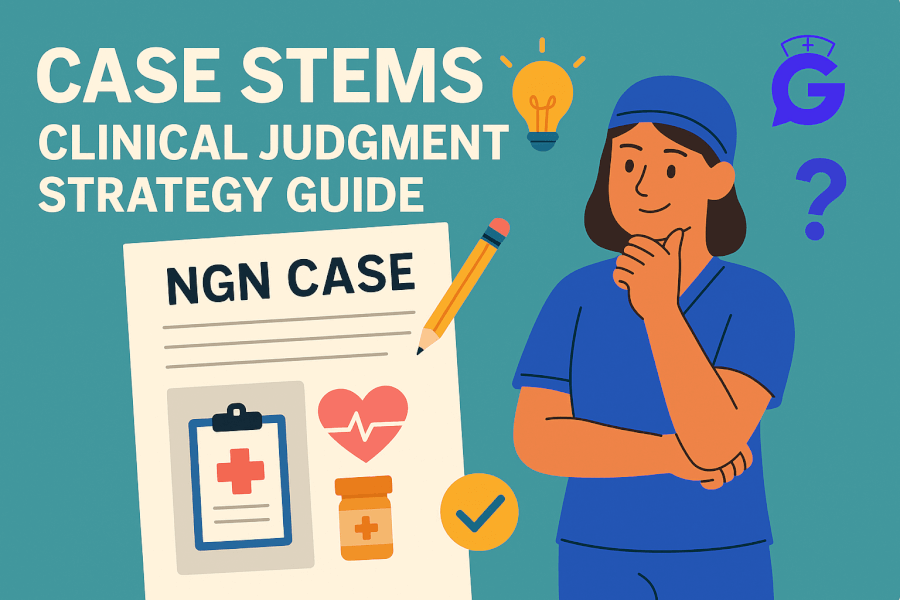Pharmacology is where clinical judgment meets safety. The NGN will ask you to recognize medication red flags, choose safe and effective actions, and select monitoring parameters that prove your intervention worked. The cases below are designed to feel like test-day screens—short, focused, and scored by relevance.
Faculty tip: Before picking anything, say one sentence in your head: “Given these cues, the priority problem is X; the two safest actions are Y and Z; I’ll monitor A and B to verify improvement.”
Table of Contents
- How to Use These Case Studies
- Case 1: Insulin—Symptomatic Hypoglycemia
- Case 2: Warfarin—Supratherapeutic INR
- Case 3: Vancomycin—Trough Too High
- Case 4: Opioid—Hypoventilation Post-Dose
- Case 5: ACE Inhibitor—Cough vs. Angioedema
- Case 6: Beta-Blocker—Bradycardia & Hypotension
- Case 7: Digoxin—Toxicity Risk with Hypokalemia
- Case 8: Magnesium Sulfate—OB Monitoring
- Case 9: Heparin—Suspected HIT
- Case 10: Lithium—Early Toxicity Cues
- FAQs
- Further Reading
🎯 Free NCLEX quiz!
Test your knowledge—new quizzes added weekly!
How to Use These Case Studies
- Read the stem, name the priority in one line, then pick two actions and two parameters you’d monitor.
- Compare to the answer/rationale and note what cues you over- or under-valued.
- For a fast primer on reading stems efficiently, see How to Read NGN Case Stems (2025): Clinical Judgment Strategy Guide.
- If you want structure for matrix/bow-tie formats, review NGN Bow-Tie Items (2025): Format, Strategy, and 10 Examples with Answers and NGN Matrix/Grid Items (2025): Format, Strategy, and 10 Examples with Answers.
Case 1: Insulin—Symptomatic Hypoglycemia
Stem (condensed): Shaky, diaphoretic client 1 hour after rapid-acting insulin; POC glucose 48 mg/dL; lightheaded and confused.
Priority problem: Acute hypoglycemia.
Two best actions:
- Give fast-acting carbohydrate (juice/glucose tabs) or IV dextrose if NPO.
- Recheck glucose in 15 minutes and repeat treatment as needed per protocol.
Two parameters to monitor: Capillary glucose; mental status.
Rationale: Restore glucose quickly to prevent neuro injury; verify response and avoid overtreatment.
Faculty tip: If oral route is unsafe (aspiration risk), go IV dextrose per protocol now—don’t delay for a call.
Case 2: Warfarin—Supratherapeutic INR
Stem: Client on warfarin with INR 5.2, minor gum bleeding; no major bleeding reported.
Priority problem: Bleeding risk from excessive anticoagulation.
Two best actions:
- Hold warfarin and notify provider; anticipate vitamin K depending on protocols/bleed risk.
- Implement bleeding precautions (soft toothbrush, avoid IM injections, fall risk).
Two parameters: Bleeding signs (stool/urine, gums); INR trend.
Rationale: Reduce anticoagulant effect and prevent injury while INR is above therapeutic.
Case 3: Vancomycin—Trough Too High
Stem: Scheduled dose due; latest trough 24 mcg/mL (above target); creatinine rising; reports tinnitus.
Priority problem: Vancomycin toxicity risk (nephro/ototoxicity).
Two best actions:
- Hold the dose and contact provider/pharmacy for dosing adjustment.
- Ensure renal function labs and document ototoxic symptoms.
Two parameters: Serum creatinine/urine output; vanco levels/symptom change.
Rationale: Prevent further toxicity and adjust regimen safely.
Case 4: Opioid—Hypoventilation Post-Dose
Stem: 30 minutes after morphine IV; RR 8–10, shallow breaths; SpO₂ 88% on room air; very drowsy.
Priority problem: Hypoventilation with hypoxia.
Two best actions:
- Elevate HOB and apply supplemental oxygen per protocol; stimulate to breathe.
- Continuous pulse oximetry; prepare to reduce dose or give naloxone if ordered/indicated.
Two parameters: SpO₂; respiratory rate/sedation score.
Rationale: Support ventilation/oxygenation first; reassess sedation and reverse if necessary.
For bow-tie patterning on similar scenarios, see NGN Bow-Tie Items (2025).
Case 5: ACE Inhibitor—Cough vs. Angioedema
Stem: New ACE inhibitor started last week. Client reports persistent dry cough today; lips/tongue normal. Later, a different client on ACE reports lip swelling and trouble swallowing.
Priority problem(s):
- Dry cough: ACE cough—non-emergent side effect.
- Lip/tongue swelling: Possible angioedema—airway emergency.
Two best actions: - For cough: Notify provider to consider switch (e.g., to ARB); reassure non-urgent.
- For angioedema: Stop ACE, assess airway, apply O₂, prepare emergency management; notify provider immediately.
Two parameters: Airway patency/voice changes; respiratory effort/SpO₂ (angioedema); for cough—symptom progression.
Rationale: Distinguish benign side effect from life-threatening reaction.
Case 6: Beta-Blocker—Bradycardia & Hypotension
Stem: Client on metoprolol; HR 48, BP 88/54, dizzy on standing.
Priority problem: Bradycardia with hypotension causing decreased perfusion.
Two best actions:
- Hold beta-blocker; assess symptoms, orthostatic vitals; notify provider.
- Ensure safety (fall precautions); consider fluids if ordered and no contraindications.
Two parameters: HR/BP/MAP; dizziness/syncope events.
Rationale: Avoid further rate reduction; protect perfusion and prevent injury.
Case 7: Digoxin—Toxicity Risk with Hypokalemia
Stem: N/V, blurred “yellow” vision, irregular pulse; on digoxin; K⁺ 3.1 mEq/L.
Priority problem: Digoxin toxicity risk, precipitated by hypokalemia.
Two best actions:
- Hold digoxin; obtain digoxin level/EKG; replace potassium per order.
- Assess for rhythm changes; continuous monitoring if symptomatic.
Two parameters: Rhythm/HR; K⁺/digoxin level; symptom trend.
Rationale: Correct precipitating cause; monitor for dysrhythmias.
Case 8: Magnesium Sulfate—OB Monitoring
Stem: Preeclampsia on magnesium infusion; reports muscle weakness; RR 10; DTRs 1+; urine output 20 mL/hr.
Priority problem: Magnesium toxicity (respiratory depression risk).
Two best actions:
- Stop magnesium infusion and notify provider; prepare calcium gluconate per protocol.
- Maintain airway support; reassess respiratory status and DTRs.
Two parameters: RR/SpO₂; DTRs/level of consciousness; urine output.
Rationale: Reverse or halt toxicity; support ventilation and enhance clearance.
Case 9: Heparin—Suspected HIT
Stem: Hospital day 5 on heparin; platelets dropped from 250k to 90k; new petechiae; aPTT therapeutic.
Priority problem: Heparin-induced thrombocytopenia (HIT) suspicion.
Two best actions:
- Stop heparin and notify provider; anticipate non-heparin anticoagulant per protocol.
- Bleeding precautions; assess for new thrombosis (calf pain, swelling, skin color changes).
Two parameters: Platelet trend; signs of thrombosis/bleeding.
Rationale: HIT is immune-mediated and paradoxically pro-thrombotic—change therapy and protect from complications.
Case 10: Lithium—Early Toxicity Cues
Stem: Client on lithium with new nausea, tremor, mild ataxia; reports dehydration after GI upset.
Priority problem: Early lithium toxicity risk, worsened by dehydration.
Two best actions:
- Hold lithium; notify provider; anticipate level check and hydration orders.
- Reinforce fluid intake and avoid NSAIDs (can raise lithium levels).
Two parameters: Serum lithium level; symptoms (neurologic/GI); fluid status.
Rationale: Prevent progression to severe neurotoxicity; correct fluid imbalance.
Faculty tip: If the action you choose changes the physiology (oxygenation, perfusion, neuro stability) and you can monitor the result within 10–30 minutes, you’re almost always on the NGN scoring path.
For a quick blueprint refresher on where these items live, review NCLEX Categories & Subcategories (Weights, Examples, Practice). For instability patterns that pharmacology often touches (e.g., hypotension, respiratory depression), see Physiological Adaptation: Key Concepts & Mnemonics. To integrate this into a study calendar, How Long Should I Study for the NCLEX? explains 4/6/8-week pacing.
FAQs
How many actions should I pick in pharmacology-heavy NGN items?
Usually two: one that fixes the immediate physiologic problem and one that prevents harm or addresses the cause.
Do monitoring parameters have to be numbers?
Often yes (SpO₂, MAP, UOP, labs), but mental status, pain, or sedation scores are valid if they reflect your intervention’s effect.
What if both “call the provider” and “nursing action” seem right?
NGN rewards actionable nursing steps you can take now to stabilize the client. Call/notify is important, but stabilize first when appropriate.
How can I avoid over-selecting on matrix/grids?
Name the priority out loud, then choose only cues/actions that support it. If an option is routine but not priority-driven, skip it.
What’s the best way to practice pharmacology for NGN?
Blend targeted case practice with timed mixed sets. Use daily micro-sessions (10–20 minutes) and escalate to longer blocks before test week.







